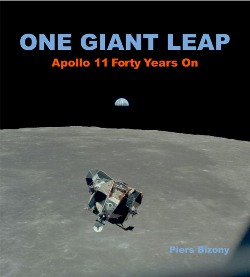 The Apollo lunar landings are, one would have thought, the perfect subject for a big copiously-illustrated coffee-table book. After all, it was a unique achievement, many people alive today still remember it vividly, and NASA documented it thoroughly – taking thousands of photographs, thousands of feet of film, and writing millions of words. Yet there are few such books available. Piers Bizony’s One Giant Leap – Apollo 11 Forty Years On is one (see here), but it was published only last year as part of the fortieth celebration of the first lunar landing. Apollo: The Epic Journey to the Moon by David West Reynolds is another. It was first published in 2002.
The Apollo lunar landings are, one would have thought, the perfect subject for a big copiously-illustrated coffee-table book. After all, it was a unique achievement, many people alive today still remember it vividly, and NASA documented it thoroughly – taking thousands of photographs, thousands of feet of film, and writing millions of words. Yet there are few such books available. Piers Bizony’s One Giant Leap – Apollo 11 Forty Years On is one (see here), but it was published only last year as part of the fortieth celebration of the first lunar landing. Apollo: The Epic Journey to the Moon by David West Reynolds is another. It was first published in 2002.
Like most books of its type, Apollo: The Epic Journey to the Moon opens with a couple of chapters introducing rocketry and the various pioneers of the field – Tsiolkovsky, Oberth, Goddard… But, of course, it is Wernher von Braun who comes to dominate post-war rocketry, and Apollo: The Epic Journey to the Moon also includes a section on his Collier’s articles from 1952 to 1954, with artwork. The book then moves swiftly through Mercury and Gemini, and onto the Apollo programme. The Soviet achievements are mentioned, but only inasmuch as they reflected on the US space programme.
Apollo: The Epic Journey to the Moon is especially good on Apollo 11, Apollo 15 and Apollo 17. However, the author is unusually dismissive of Apollo 14, describing the mission as the lowest point of the programme. Each mission’s section is accompanied by diagrams and photographs, including diagrams of the geology of the Moon as discovered by each mission. There are also brief sections on Advanced Apollo and Skylab, but the Shuttle is mentioned only in passing.
However, it’s in the last section of the final chapter that Apollo: The Epic Journey to the Moon stumbles and falls. Putting twelve men on the Moon was an astonishing achievement. It was certainly motivated by politics – although whether chiefly to boost Kennedy’s flagging popularity or beat the Russians after the embarrassments of Sputnik and Gagarin is debatable. But it was only during the fact that it may have been characterised, by some of the more jingoistic commentators, as an undertaking intended “to demonstrate the superior ability of the superior system, capitalism versus communism”. Nor did “the battle prove out the more capable system”. Now, in the twenty-first century, forty years after Apollo 11, the Russian Soyuz is still happily lofting cosmonauts into orbit, while the Space Shuttle has suffered two catastrophic accidents and is due to be retired this year. Given that Apollo: The Epic Journey to the Moon was published in 2002, the author must have been aware of this.
It is also disingenuous to claim that Apollo beat the Soviets to the Moon due to “free enterprise”. The Apollo programme was a government-run and -funded programme, which fed work and money to huge numbers of companies. James Webb intended it as such. The Republicans killed the Apollo programme in part because they saw it as socialist.
Apollo: The Epic Journey to the Moon starts well, and contains much interesting information. The photographs are well chosen, and the diagrams are excellent. But the conclusions the author draws in the final chapter are neither accurate nor useful, and that spoiled the book for me.
Apollo: The Epic Journey to the Moon, David West Reynolds (2002, Tehabi Books, ISBN 0-15-100964-3, 260pp + bibliography and index)

